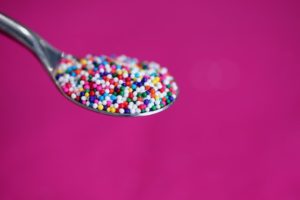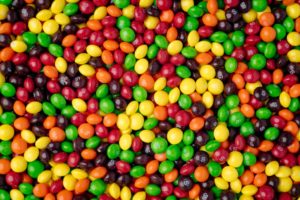Are the color additives in your food potentially harmful? Food coloring is regulated by the Food and Drug Administration (FDA), which suggests that consuming food products that contain food coloring should be safe.

However, that is not the case. In fact, thousands of imports from around the world are deemed unsafe, due to the color additives. The U.S. keeps an ongoing list of foods that put consumers’ health at risk because they contain illegal and/or undeclared colors.
Types of color additives (and some come from bugs)!
Color additives are common within the modern food industry. From candy to fruit juices, they are added by manufacturers to make certain foods visually appealing and instantly recognizable.
Additives come from multiple sources, both natural and synthetic. For example, a specific red color additive known as red carmine comes from the cochineal bug and is FDA-approved. Color additives are classified in three different categories:
- Straight colors: Color additives that have not been mixed or chemically reacted with any other substance (for example, Blue No.1).
- Lakes: Formed through chemical reactions with straight colors (e.g., Blue 1 Lake).
- Mixtures: Formed by the mixing of color additives without a chemical reaction (e.g., food inks used to mark confectionery).

Bug used to make red carmine food coloring. Photo credit: Vahe Martrosyan
Red Dye 40 linked to ADHD
Research has shown that Red Dye 40 and other synthetic color additives may have links to ADHD symptoms and other neurobehavioral conditions. While the FDA has previously claimed that synthetic color additives have no adverse effects, recent research says otherwise. Multiple agencies in California collaborated on a 2021 report indicating that hyperactivity and other neurobehavioral issues occur among children who consume synthetic food dyes.
Researchers believe that these synthetic color additives may cause neurobehavioral issues due to:
- Mineral depletion, such as zinc and iron
- Chemical changes within the brain
- Hypersensitivity or allergic reactions
Much of the research has been focused on children. Adverse effects have been found to occur in children with pre-existing conditions like ADHD and in children without such conditions. If this is a cause for concern, you may want to keep an eye on product labels for Red Dye 40. The additive may also go by other names such as:
- Allura Red AC
- Red 40
- Red 40 Lake
- FD&C Red No. 40
- Aluminum Lake
The Skittles lawsuit
A lawsuit was filed in July 2022 against Mars, the corporation that produces Skittles. The lawsuit argues that Skittles candies are unfit for human consumption due to titanium dioxide, a common artificial food coloring used to make colors more vibrant.
Mars responded with a statement noting that artificial colors, such as titanium dioxide, were not “ingredients of concern” for its global market. However, this statement is misleading. Mars did in fact prioritize the removal of artificial colors in its European products, including titanium dioxide. In some European markets where titanium dioxide is permitted, a warning label is still required for packaging.
Despite being recognized as a safe additive by the FDA, titanium dioxide has been classified as a possible carcinogen according to the International Agency for Research on Cancer. While it may have negative side effects, it remains unclear whether the chemical creates long-term and permanent damage to consumers.
What if I got sick due to a food color or additive?
If you have experienced a foodborne illness due to the negligence of another person or business, call us today to discuss your unique situation. The experienced foodborne illness attorneys at Allen & Allen can help. Call 866-388-1073 for a free consultation.





